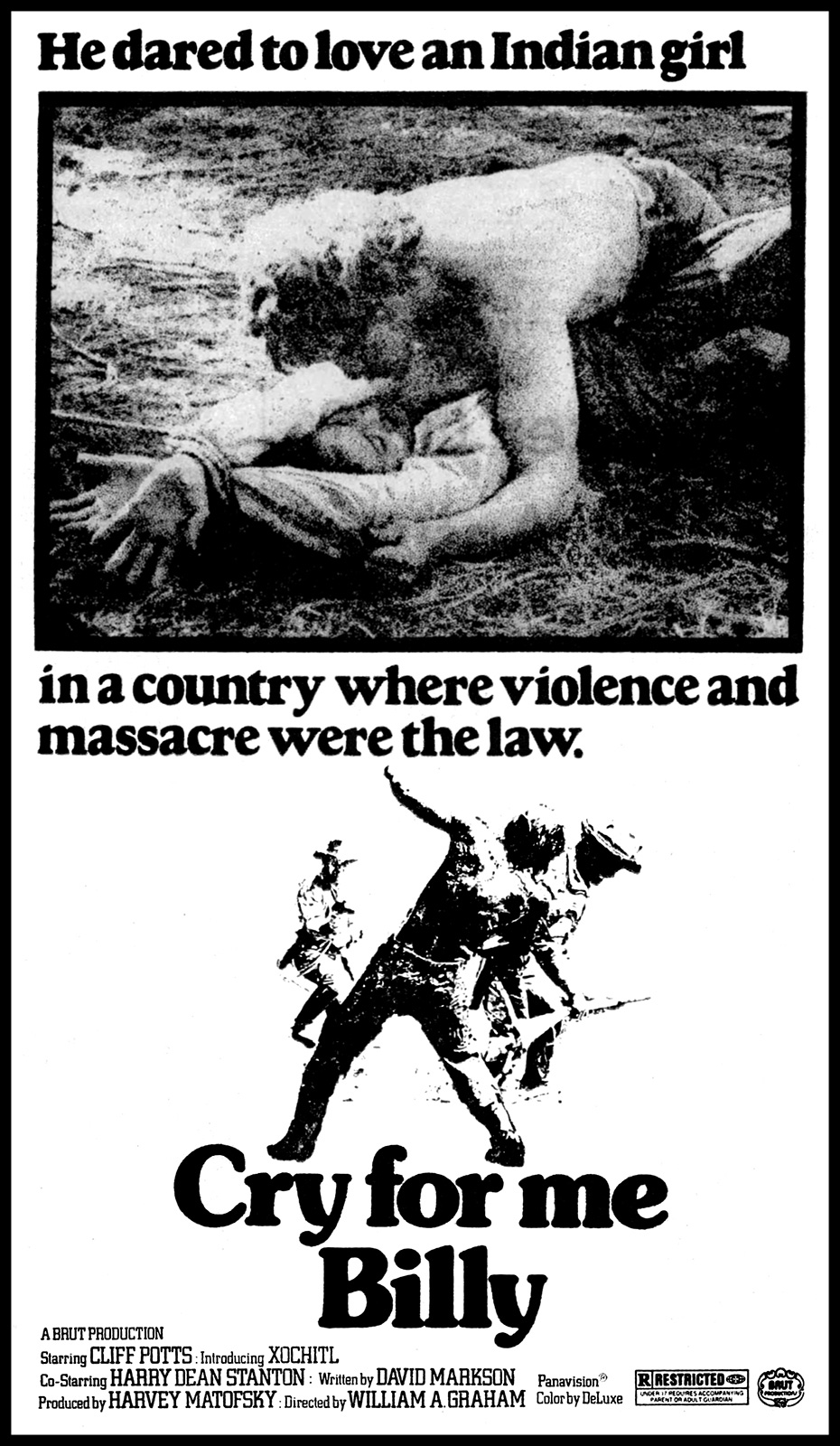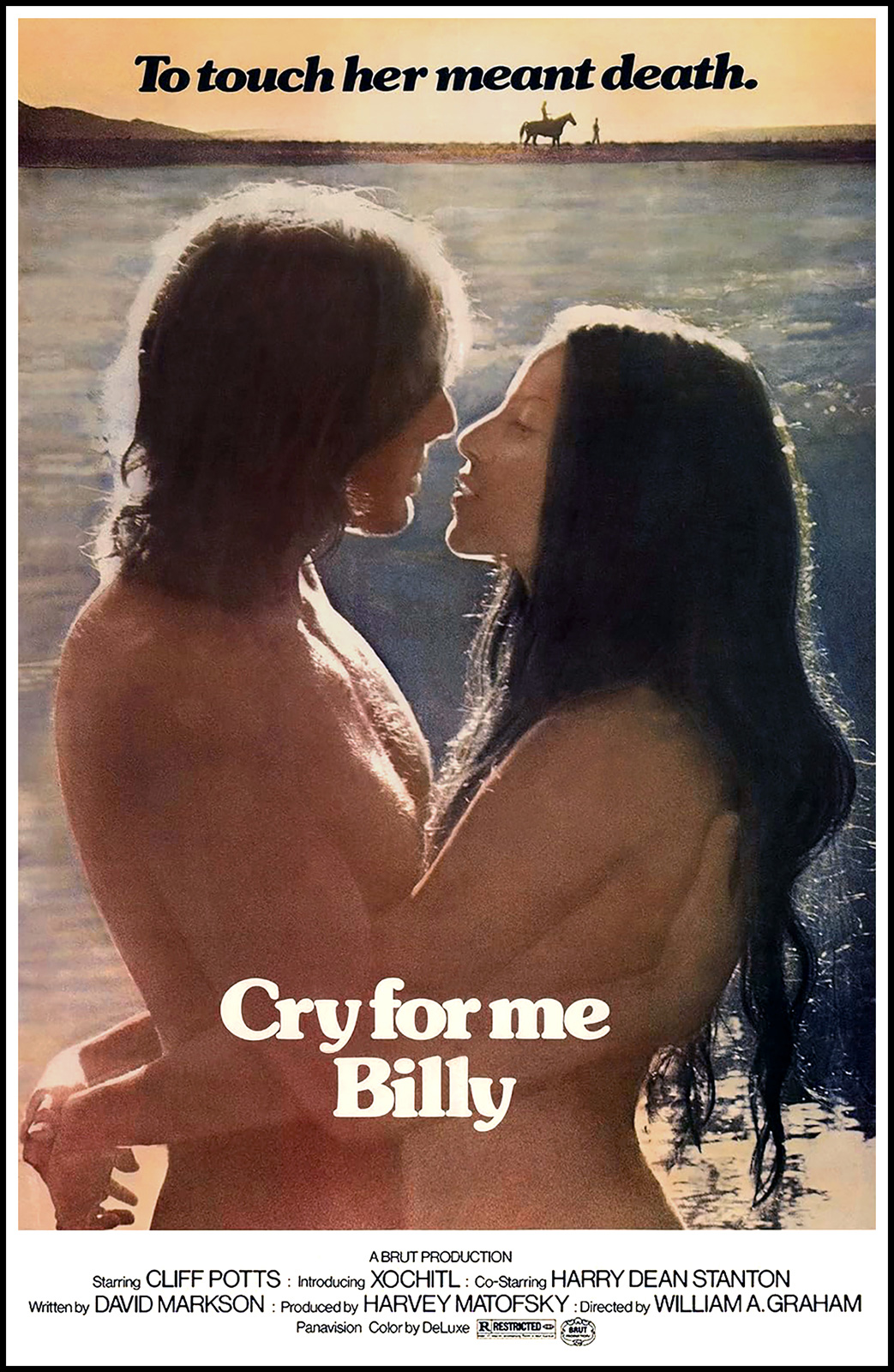|
 A disillusioned gunfighter falls for a Native American "squaw" in this unconventional period-western meet-cute, featuring moments of grim violence, sentimental romance and one highly exploitable element -- its lovely lead actress is nude throughout much of the film! Shot in late-1971 by director William A. Graham (whose eclectic features ranged from Elvis Presley's CHANGE OF HABIT, to the backwoods family drama WHERE THE LILIES BLOOM), its subversive approach fit comfortably alongside other revisionist westerns of that period like LITTLE BIG MAN, DOC and McCABE AND MRS. MILLER. Producer Elliott Kastner then debuted the film at Cannes in 1972 as BILLY; later that year, it played the Atlanta Film Festival, with its title changed to COUNT YOUR BULLETS; had its LA theatrical premiere in July 1974 as FACE TO THE WIND; but didn't get a nationwide US release until three years later, now entitled CRY FOR ME BILLY, at which time the western genre had fallen out of favor with audiences. Though not without its faults, this earnest and unusual film certainly deserved a better fate... Cliff Potts stars as Billy Williams, a young mercenary dissatisfied with his unsavory current routine. When a handful of "heathen" Native Americans escape from imprisonment by the US Cavalry, all but one ends up massacred, with Billy stumbling upon and rescuing the lone survivor -- a naked young woman (Xochitl) who doesn’t understand English. Initially frightened by the gunman, he feeds and clothes her, tends to her injuries and helps
A disillusioned gunfighter falls for a Native American "squaw" in this unconventional period-western meet-cute, featuring moments of grim violence, sentimental romance and one highly exploitable element -- its lovely lead actress is nude throughout much of the film! Shot in late-1971 by director William A. Graham (whose eclectic features ranged from Elvis Presley's CHANGE OF HABIT, to the backwoods family drama WHERE THE LILIES BLOOM), its subversive approach fit comfortably alongside other revisionist westerns of that period like LITTLE BIG MAN, DOC and McCABE AND MRS. MILLER. Producer Elliott Kastner then debuted the film at Cannes in 1972 as BILLY; later that year, it played the Atlanta Film Festival, with its title changed to COUNT YOUR BULLETS; had its LA theatrical premiere in July 1974 as FACE TO THE WIND; but didn't get a nationwide US release until three years later, now entitled CRY FOR ME BILLY, at which time the western genre had fallen out of favor with audiences. Though not without its faults, this earnest and unusual film certainly deserved a better fate... Cliff Potts stars as Billy Williams, a young mercenary dissatisfied with his unsavory current routine. When a handful of "heathen" Native Americans escape from imprisonment by the US Cavalry, all but one ends up massacred, with Billy stumbling upon and rescuing the lone survivor -- a naked young woman (Xochitl) who doesn’t understand English. Initially frightened by the gunman, he feeds and clothes her, tends to her injuries and helps  "Little Sparrow" (as she's named in the end credits, though Billy never actually calls her that) elude the Cavalry. Trust issues occasionally arise, but the two soon become unlikely traveling companions across the desert wilderness. When they aren't running into various grizzled dirtbags, a large chunk of the film's second half focuses on the duo's growing affection. Alas, their happiness (complete with a sappy, forgettable love song as the pair cavort about in nature) is fleeting, since soldiers soon appear, injuring Billy and subjecting Little Sparrow to a protracted gang rape during its particularly brutal final reel. Ultimately, Billy returns to his old ways and seeks revenge... Beautifully shot in New Mexico by cinematographer Jordan Cronenweth (BLADE RUNNER, ALTERED STATES), the film's success rests firmly on its two lead characters, but the script by David Markson (who was undoubtedly disillusioned by Hollywood after the 1970 adaptation of his novel The Ballad of Dingus Magee cast 55-year-old Frank Sinatra as his 19-year-old outlaw protagonist) never gives either actor much to work with. Potts, following supporting roles in SILENT RUNNING and SOMETIMES A GREAT NOTION, does a credible job with his highly physical role, but it's harder to gauge Xochitl's screen debut, since her part has even less dialogue than clothing. The two stars became a couple soon afterward and were married for eight years, and while the film's publicity claimed Xochitl was a Aztec Indian from New Mexico, she was actually Californian Mary Yolanda Aguayo. Harry Dean Stanton also turns up briefly as an old colleague who tries to recruit Billy for a dangerous job, Don Wilbanks is a sadistic sergeant, Woodrow Chambliss plays a helpful prospector, plus Roy Jenson and James Gammon are Injun-loathing supporting dirtbags. Despite its somewhat aimless nature, this is a well-intentioned drama with earnest performances, loads of atmosphere and a bleak downer of an ending. "Little Sparrow" (as she's named in the end credits, though Billy never actually calls her that) elude the Cavalry. Trust issues occasionally arise, but the two soon become unlikely traveling companions across the desert wilderness. When they aren't running into various grizzled dirtbags, a large chunk of the film's second half focuses on the duo's growing affection. Alas, their happiness (complete with a sappy, forgettable love song as the pair cavort about in nature) is fleeting, since soldiers soon appear, injuring Billy and subjecting Little Sparrow to a protracted gang rape during its particularly brutal final reel. Ultimately, Billy returns to his old ways and seeks revenge... Beautifully shot in New Mexico by cinematographer Jordan Cronenweth (BLADE RUNNER, ALTERED STATES), the film's success rests firmly on its two lead characters, but the script by David Markson (who was undoubtedly disillusioned by Hollywood after the 1970 adaptation of his novel The Ballad of Dingus Magee cast 55-year-old Frank Sinatra as his 19-year-old outlaw protagonist) never gives either actor much to work with. Potts, following supporting roles in SILENT RUNNING and SOMETIMES A GREAT NOTION, does a credible job with his highly physical role, but it's harder to gauge Xochitl's screen debut, since her part has even less dialogue than clothing. The two stars became a couple soon afterward and were married for eight years, and while the film's publicity claimed Xochitl was a Aztec Indian from New Mexico, she was actually Californian Mary Yolanda Aguayo. Harry Dean Stanton also turns up briefly as an old colleague who tries to recruit Billy for a dangerous job, Don Wilbanks is a sadistic sergeant, Woodrow Chambliss plays a helpful prospector, plus Roy Jenson and James Gammon are Injun-loathing supporting dirtbags. Despite its somewhat aimless nature, this is a well-intentioned drama with earnest performances, loads of atmosphere and a bleak downer of an ending.
© 2025 by Steven Puchalski.

|